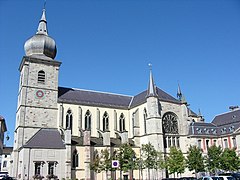Remiremont
| Remiremont | ||
|---|---|---|

|
|
|
| region | Grand Est | |
| Department | Vosges | |
| Arrondissement | Epinal | |
| Canton | Remiremont (main town) | |
| Community association | Porte des Vosges Méridionales | |
| Coordinates | 48 ° 1 ′ N , 6 ° 35 ′ E | |
| height | 379-762 m | |
| surface | 18.00 km 2 | |
| Residents | 7,714 (January 1, 2017) | |
| Population density | 429 inhabitants / km 2 | |
| Post Code | 88200 | |
| INSEE code | 88383 | |
| Website | www.remiremont.fr | |
 Location of the town of Remiremont in the Vosges department |
||
Remiremont ( German Romberg , less common variations are Reimersberg or Rumsberg ) is a French commune with 7,714 inhabitants (as of January 1, 2017) in the Vosges department in the Grand Est region (until 2015 Lorraine ). It is also the main town (chef-lieu) of the canton of the same name .
geography
In the urban area of Remiremont, the Moselle receives its first major tributary, the Moselotte , which joins from the right . Remiremont is on the edge of the Ballons des Vosges Regional Nature Park , with which it is associated.
Neighboring municipalities of Remiremont are Saint-Étienne-lès-Remiremont in the northeast, Dommartin-lès-Remiremont in the east and southeast, Le Val-d'Ajol in the south and Saint-Nabord in the west and northwest.
history
The name of the place comes from Romaric , a nobleman at the court of Austrasia in Metz ; In 620 he received the Villa Habendum in the Vosges from King Chlothar II , which he made the nucleus of a monastery in which he lived for 30 years. He died in 653. Amé , a preacher, monk and disciple of St. Columban of Luxeuil , participated in this foundation. Bishop Arnulf von Metz , the progenitor of the Arnulfingers and Carolingians , died nearby, probably in the year 640, and was buried in the monastery until he was later transferred to Metz. A Carolingian royal court was built in the vicinity of the monastery . On February 6, 1284, Rudolf I married Isabella of Burgundy in Remiremont .
In 910, a women's monastery was founded near the men's monastery, which became one of the most important in the Holy Roman Empire and the city of Remiremont was under the protection of it. Gradually, the original monastery developed into a community of canonesses, secular and feudal, the Chapitre de Remiremont , which was reserved for young women from the high nobility. About 50 nobles lived here in wealth, as the abbey had numerous possessions and the abbess held the rank of princess. Medieval German names for the monastery are "Rumberc" (13th century) and "Rombech" (1410). In the 15th century, the abbey came under the rule of the Dukes of Lorraine , who assumed the title of Count of Remiremont . This situation did not last long at the beginning of the French Revolution : on December 7, 1790, the monastery church was closed.
Remiremont was the capital of an arrondissement until September 10, 1926 and has been part of the Épinal arrondissement since then .
Population development
| year | 1962 | 1968 | 1975 | 1982 | 1990 | 1999 | 2007 |
| Residents | 9,350 | 9,312 | 10,552 | 9,985 | 9,068 | 8,538 | 8,104 |
Attractions
- Remiremont Abbey with the former Saint-Pierre collegiate church (consecrated in 1049, rebuilt several times), hall crypt (11th century), flanked by two single-nave side crypts
- Abbesses' palace (1752), today the town hall, court and library
- Canonary houses of noble canons (17th and 18th centuries), near the collegiate church
- Musée Charles Friry (paintings, religious minor art) in a house of canonesses (some rooms with original 18th century furnishings)
- Musée Fondation Charles de Bruyère (prehistory and early history, paintings, sculptures) in another house of canonesses
- Houses on Rue Charles-de-Gaulle with arched arcades, built in the 17th and 18th centuries
Personalities
- Arnulf von Metz , saint, bishop of Metz , ancestor of the Arnulfingers and the Carolingians died on July 18th, probably 640 near Remiremont
- Waldrada († after 868), Friedelfrau of King Lothar II of Lorraine (approx. 835–869)
- Blessed Alix Le Clerc (1576–1622) sister and founder of the order
- Abbé Bexon (1748–1784), French naturalist, collaborator with Buffons ( Histoire naturelle )
- Félix Jules Méline (1838–1925), repeatedly Minister of Agriculture and Prime Minister from 1896 to 1898, founder of the Crédit Agricole bank
- Léon Werth (1878–1955), writer and art critic
- Raoul Bachmann (1884–1934), racing car driver
- Christian Poncelet (* 1928), politician (UMP), President of the Senate since 1998 and mayor of the city for many years
- Julien Absalon (* 1980), 2004 Olympic champion on a mountain bike
- Clément Noël (* 1997), ski racer
Others
In the " Love Council of Remiremont ", an anonymous parodic controversial poem from the 12th century, the question of whether clerics or knights are better lovers is negotiated in Latin verses based on the model of theological councils and in the style of the Minnehöfe - in the Remiremont nunnery.
The Carnaval venitien of Remiremont in the style of the Carnival in Venice has achieved national fame .
Web links
Individual evidence
- ^ Geographical-Historical-Statistical Newspaper Lexicon (1811) Col. 41




